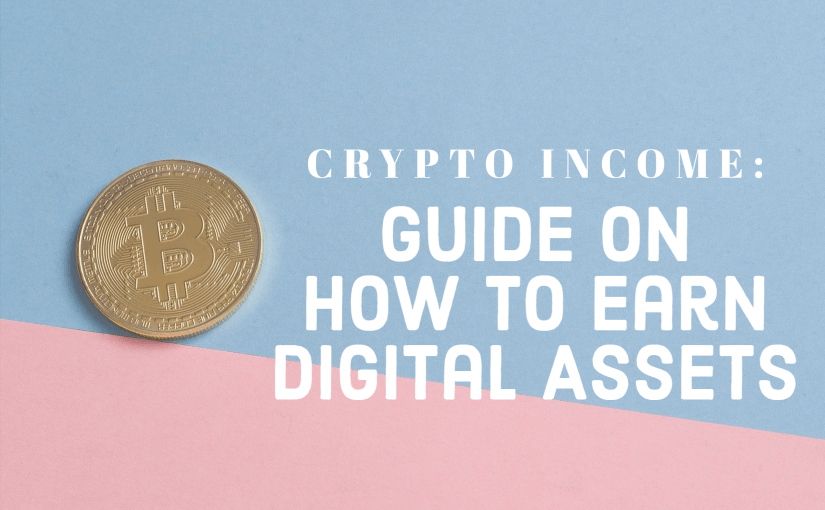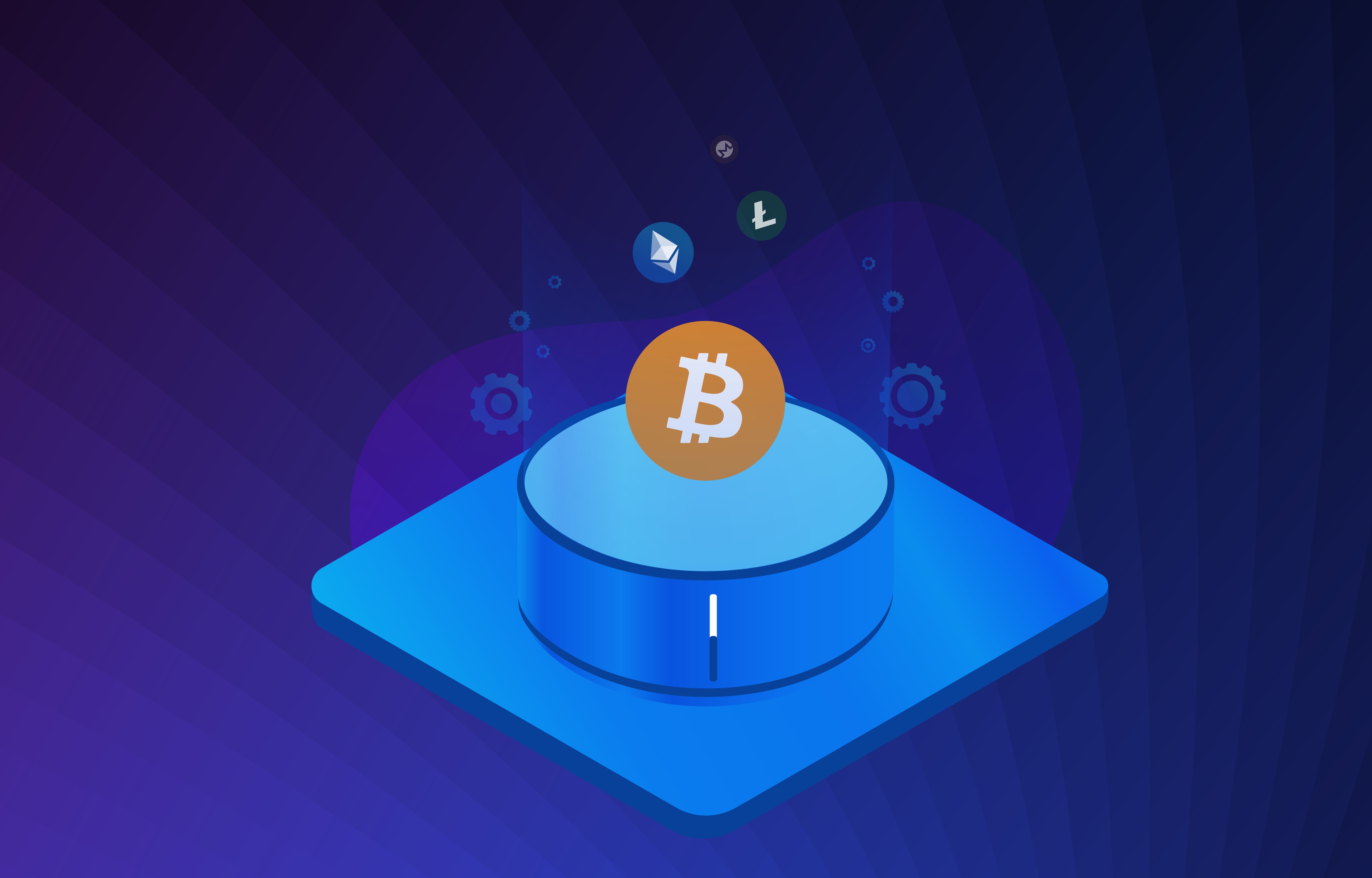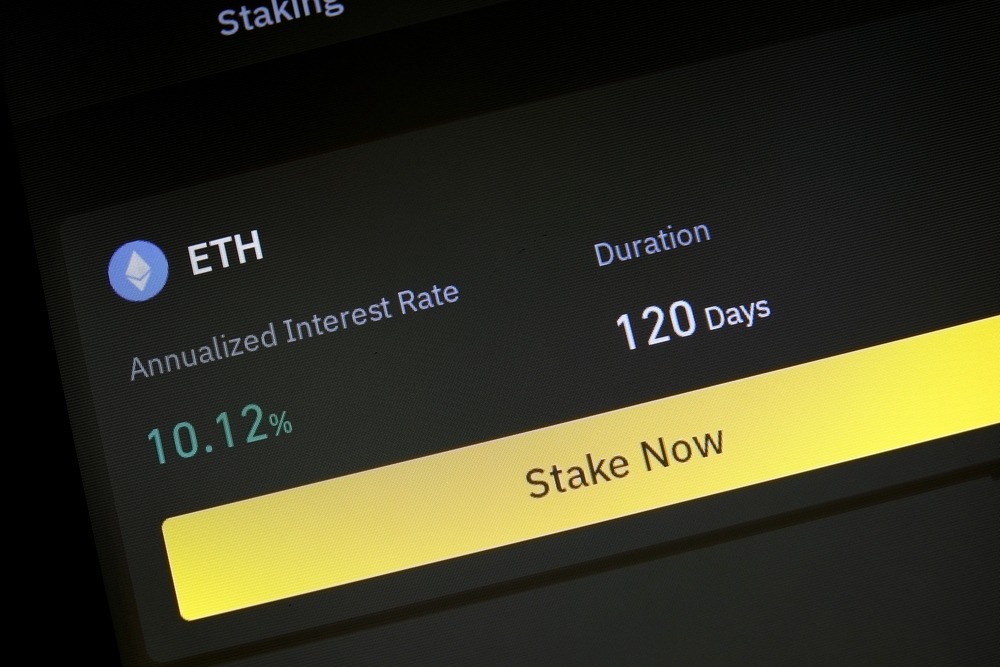Crypto Income: The Ultimate Guide On How To Earn Digital Assets

Have you ever stopped to wonder how people are pulling in steady income from cryptocurrency? Sure, we’ve all heard about buying and holding Bitcoin, waiting for its value to soar. But here’s the thing – smart crypto enthusiasts are doing so much more than that. They’re staking, lending, participating in affiliate programs, and even earning through things like airdrops or NFTs. The possibilities are massive, but figuring out where to start can feel overwhelming.
This guide is here to help. Think of it as your map to unlocking those hidden opportunities and turning your digital assets into multiple income streams. Whether you’re a novice or have already dipped your toes in, by the time you’re through, you’ll know exactly how to position yourself for consistent earnings in the crypto space.
It is perfectly okay to feel bad about failing to possess the insight and the conviction to invest in cryptocurrency before the start of the ongoing bull cycle. Merely thinking about the potential profit and the missed opportunities could demoralize and force investors to make hasty and bad investment decisions.
From what I have learned over the years, there is no bad timing when it comes to cryptocurrency. There are always new opportunities around the corner. The most important thing is to devise a viable strategy for generating crypto income and set up multiple fail-safes to minimize risks. But first, you ought to understand the various ways of earning cryptocurrency safely. In this guide, I will explore the popular income-generating activities peculiar to the crypto industry as well as their pros and cons.

Why Earning Crypto Income Can Be Challenging (But Worth It!)
Let’s not sugarcoat it—earning crypto income isn’t a magical money-making scheme. If it were easy, everyone would be doing it! There are market dips that could wipe out your gains, overly hyped trends that might vanish overnight, and let’s not even get started on scams lurking behind every other “too-good-to-be-true” opportunity.
But here’s the upside: with the right knowledge and approach, you can overcome the challenges. It’s not about luck; it’s about strategy. Building a reliable income stream with crypto is not just possible but incredibly rewarding if you know what you’re doing. And spoiler alert – it’s not all technical stuff! Everyday people are doing this, and so can you.
Not Just “Buy and Hold”: The Need for a Smarter Income Strategy
“Buy low, sell high” might sound like a winning mantra, but here’s the truth: relying solely on price growth is a risky game in today’s highly volatile crypto market. What happens when your crypto portfolio doesn’t skyrocket as planned? Do you sit and wait it out?
The better approach? Diversification. Instead of playing the long waiting game, you can start earning with your assets through smart strategies like staking, lending, or even participating in reward programs. Think of it like putting your money to work for you – because in this digital economy, your crypto shouldn’t just sit idly in a wallet.
The Main Pain Points of Starting
Starting to earn crypto income can feel like stepping into a maze. Where do you even begin? Should you trust staking schemes that promise high returns? Is it worth investing in cloud mining or attempting to cash in on affiliate programs? And let’s not forget the endless stream of bogus “get rich quick” schemes you have to sift through.
Here are the most common barriers people face:
- Risk vs Reward: Is staking or cloud mining worth the initial investment?
- Information Overload: Dozens of strategies, but which one is the easiest and safest to try?
- Scams and Losses: How do you filter out fake platforms, shady promises, and high-risk offers?
Getting through these challenges is possible – and it’s about more than just avoiding mistakes. It’s about understanding the different income streams and figuring out which one matches your goals. That’s exactly what we’ll explore ahead.
You’ve heard the saying, “Don’t put all your eggs in one basket.” Well, what about using your crypto in ways you didn’t even know existed? Stay with me, because next up, we’ll unlock one of the easiest ways to get started: staking your crypto and earning rewards while keeping your digital assets safe. Sound good?

Why Is It Advisable To Earn Cryptocurrency?
In the last decade, cryptocurrencies have showcased a variant of functionalities that somewhat elevates their value. Most digital assets incorporate deflation mechanisms to ensure that their value maintains an upward trajectory regardless of the prevailing economic realities. As you must have noticed, the purchasing power of 1 BTC in 2020 is nowhere near what 1 BTC can buy today. The same is true for most digital assets.
Therefore, if you had earned cryptocurrency for the better part of 2020, then the value of your earnings would have increased exponentially. In contrast, most fiat currencies are reeling from the effects of inflation. Therefore, the buying power of an individual earning in fiat currencies, especially those devalued for one reason or the other, would have reduced in that same time.
Understandably, this is one of the reasons for the high demand for crypto income opportunities. Just as large companies are adopting Bitcoin as a hedge against inflation, individuals are also increasingly exploring and implementing ways to preserve the value of their savings with crypto. The obvious solution for such individuals is the possibility of earning in digital assets.
Apart from the apparent inflation-hedging capability of cryptocurrency, they also unlock a thriving economy that borders on autonomy. The decentralized economy, as it is called, provides various means by which average investors can enjoy financial freedom and unlimited access to an inclusive financial landscape. With crypto, your background, educational status, or geographical location does not restrict the opportunities accessible to you. It also has a knack for reducing the overhead cost of processes by eliminating the input of third parties.
Hence, you can easily set up a profitable venture and have complete control over your investment such that you are not losing a significant share of the profit to intermediaries. Judging by the benefits of earning crypto, it is no surprise that a majority are looking to adopt profitable crypto ventures. While this is a given, it is important to mention that such ventures are either passive or active.

What Are Active And Passive Crypto Incomes?
An Active income is the earnings generated by providing services or actively engaging in the processes involved. More often than not, you have to invest your time, skill, and capital to generate an active income.
On the other hand, a passive income is the earnings resulting from ventures or businesses which do not require much of your input other than your funds. Here, all you are bringing to the table is your capital. Think of it as a form of investment, which is not time or energy-consuming.
With these definitions, I am sure that it is easier to differentiate between passive crypto income opportunities and active ones. The next two sections of this guide will discuss these two types of crypto income and the opportunities associated with each.

Active Crypto Income
As explained earlier, expect the requirements for earning active crypto to be a bit demanding. You are not just required to invest your time, but you also have to learn one or two skills and maybe set aside capital to start. Anyone planning to generate this type of income should be prepared to participate actively in the crypto economy. Sounds interesting? Here are some of the things or activities you can do to earn active income in the crypto sector.

Crypto Mining
Crypto mining functions as a security and coin distribution mechanism for blockchain networks, including Bitcoin, that use the proof of work consensus protocol. Such blockchains eliminate the need for a centralized authority by promoting a mining ecosystem where miners compete by using their computing resources to solve difficult puzzles.
At every given point, the first miner to solve the puzzle gets to verify and attach the next block of transactions to the blockchain. In return, the network rewards the miner with newly minted coins. The miner also earns the commission generated from each transaction entered into the new block.
In essence, miners are adequately incentivized to compete, solve mathematical puzzles and subsequently verify new transactions. The reward and the transaction fees are the active income associated with crypto mining. While this explanation aptly describes the fundamentals of crypto mining, there are way more technicalities required to run profitable mining operations.
For one, mining as a crypto income opportunity is increasingly becoming unprofitable to solo miners. This is due to the growing difficulty of crypto mining activities. Note that blockchains that support mining have set a fixed interval for the creation of new coins. When the total computing power of the mining hardware connected to the blockchain increases, the network will automatically increase the mining difficulty. The reverse is the case when there is a drop in the number of miners trying to find a new block.
And since the popularity of mining has surged over the years, the mining difficulty of most blockchain networks has maintained an uptrend. Therefore, miners have had to invest in acquiring more computing power to stand a chance of finding new blocks and earning income.
For instance, it was possible to mine Bitcoin with everyday computers in the early years of its existence. However, as the mining difficulty increased, miners were forced to opt for GPU mining rigs for a more efficient and profitable operation. Today, GPUs are no more in vogue. Now, miners use the Application-Specific Integrated Circuit (ASIC) that are tailor-made for mining cryptocurrencies. This machine is way expensive to acquire and maintain than the previous generations of mining hardware.
Not only are miners paying significantly high capital to buy and set up this hardware, but they also incur recurring expenses for running and cooling mining rigs 24/7. Therefore, if you intend to delve into the mining economy, you must consider the initial cost for purchasing mining rigs and the subsequent cost for maintaining them.
Another thing you need to consider is the time and technical requirements. As a solo miner, you need to run a node on the blockchain network and ensure that it is always online. The technicalities involved in operating a node, its time-consuming nature, and the capital and energy-intensive aspects of mining operations are potential barriers. Any of these factors, or a combination of two, can cause a miner to incur losses. Another potential barrier is the value of the cryptocurrency in question. Mining tends to be less profitable during a bear market.
As such, it comes as no surprise that mining is fast becoming a corporate venture as companies with enough funds, computing power, and technical prowess can only thrive. These entities often set up large crypto mining farms at locations with constant and affordable power supply. For those that do not possess this financial capacity but are still interested in actively partaking in the crypto mining sector, the next best option is a mining pool.
You may be wondering: what is a mining pool? Well, this is simply a network of miners that have agreed to combine their computing power and direct it towards a single mining node. In essence, solo miners understand that the only way to compete with large mining farms is to join networks that allow members to work together to achieve a similar goal of finding new blocks.
Since mining pools rely on the cumulative output of a network of miners, the revenue is shared among contributing members accordingly. Your share of the computing output of the mining pool would determine your share of the reward generated.

Crypto Trading
The second active crypto income-generating activity is trading. As practiced in traditional asset markets, you can capitalize on the price movements of digital assets and earn profits. As expected, this activity has its peculiar technicalities. To become a successful crypto trader, you must be versed in the art of predicting price movements and managing risks.
Note that the crypto market is popular as a trading terrain because of its inherent volatility. In the crypto universe, wild price swings of digital assets are normal occurrences. Therefore, traders often anticipate short-term price movements and enter trades in hopes of exiting their position with more coins than they started with. While this may seem speculative, professional crypto traders rely on quality technical and fundamental analyses to identify market trends and price movements. Wrong or poor analysis can potentially lead to significant losses.
it is also critical to access standard tools to ensure that all trading analyses are effective. This is why expert traders are often picky when it comes to exchanges. They prefer to use exchange platforms that come with all of the tools and systems necessary for entering and exiting positions without having to worry about liquidity or the effect of a poor trading terminal.
When trading cryptocurrency, there are certain precautions that you need to consider. The first is the negative impact of emotion when trading. The goal is to eliminate elements of greed or fear while making trading decisions. You do not want your emotions to skew your actions. Analytic-backed decisions should the basis on which your entire trading operations are being built upon.
Another factor that is worth mentioning is the transaction fees of your preferred crypto exchange. Since you are going to be trading frequently, you have to consider the long-term effects of accumulated fees on your profit. Then there are the risks that come with crypto trading. Remember that you are dealing with unprecedented volatility. Hence, the risk involved is quite high. Therefore, you must take risk management seriously. Implement stop loss when necessary and do not forget that the bigger the opportunity, the higher the risks involved.
You should also research the security architecture of your preferred crypto exchange. Since you are likely to hold a significant sum of digital assets on exchange wallets, you are therefore at the mercy of your trading platform’s security expertise. As such, when evaluating your risk management system, also remember to scrutinize the security measures adopted by your exchange and the fail-safes put in place to respond adequately to hacks.
Furthermore, there are various approaches to day trading. You can choose to focus on futures, instead of trading physical cryptocurrencies. Trading crypto futures contracts make it possible to profit off the price fluctuations of digital assets without having to take up the security risk of holding cryptocurrencies.
Alternatively, you can opt for margin trading. Here, you borrow cryptocurrency to increase your earning power when trading. Note that this trading strategy is way riskier than spot trading. Just as margin trading increases the potential profit, it also multiplies the potential loss. Hence, only dabble into this trading terrain when you are sure that you have acquired the level of skill and experience required to maneuver such a risky venture.
If margin trading seems to be too technical, then you can opt for arbitrage trading. The crypto market, thanks to the siloed nature of exchanges, offers arbitraging opportunities. More often than not, the prices of digital assets across exchanges are not uniform. You can therefore capitalize on market inefficiencies by buying a digital asset on one exchange at a cheaper rate and selling it on another platform with a slightly higher price rate. The difference between the buy and sell price would determine your profit.
However, note that the possibility of profiting off arbitrage opportunities shrinks as more traders increasingly take advantage of them. Hence, when it comes to crypto arbitraging, speed is the name of the game. You could also adopt trading bots to increase the probability of identifying market inefficiencies and executing the appropriate trades instantly.

Crypto Passive Income: Why Staking Could Be Your Easiest Start
If you’re like most people exploring ways to earn passive crypto income, you’d probably want something that doesn’t require a PhD in blockchain or tens of thousands of dollars to invest upfront. That’s where staking comes in—it’s simple, reliable, and perfect for beginners. Imagine earning rewards just by holding your crypto securely. Sounds good, right?
But wait! Before you rush in, let’s break it down and explore why staking could be the easiest way to get started and what you need to know to avoid any surprises along the way.
What Is Staking, and How Does It Work?
If you’ve heard the term “staking” but it still feels like crypto mumbo-jumbo, don’t worry—you’re not alone. Here’s the simple version:
Staking means locking up your cryptocurrency in a network to help secure and validate transactions. In return, the network pays you rewards. Think of it like earning interest in a savings account but with a crypto twist. The big difference? The reward rates can often blow traditional savings accounts out of the water.
Some popular staking coins include:
- Ethereum 2.0 (ETH): Secure the Ethereum network and earn rewards for supporting its move to a more sustainable proof-of-stake model.
- Cardano (ADA): A low-risk option, great if you’re looking for consistent rewards with a dedicated community backing the network.
- Solana (SOL): Known for its speed – and its staking program delivers reasonable returns.
- Polkadot (DOT): If you like high returns, this one’s worth checking out. Just keep in mind the risks of market fluctuations.
What’s awesome is that staking doesn’t require fancy mining rigs or heaps of electricity. You just pick a coin, hold it, delegate your wallet to a validator, and kick back while earning rewards.
“Passive income can feel like magic, but only when you understand how the gears turn.”
With staking, those gears are all about supporting the blockchain network through validation—the core of why this system works so smoothly.
How to Pick a Coin for Staking
Not all staking options are created equal. While staking can be a fairly straightforward entry point, success depends on choosing the right coin. Here are a few things to keep in mind:
- ROI (Return on Investment): Check what percentage you’ll earn annually. For example, staking DOT might offer upwards of 10–12%, while ETH might hover closer to 5–7%. Higher returns don’t always mean better; sometimes, they’re riskier.
- Coin Stability: Will the coin actually grow or hold its value? Projects with strong roadmaps—like ADA and ETH—are safer bets.
- Lock-Up Period: Some coins require you to lock your funds for a certain time. With Ethereum, for instance, unlocking your funds currently isn’t instant, so stay aware of these timelines.
- Validator Transparency: Choosing the right validator is crucial—they’re the middleman responsible for securing the network and sharing staking rewards. Only go with reputable, high-uptime validators.
The bottom line? Do your homework. For example, ask yourself if you believe in the project long-term or if the staking rewards outweigh your potential risks. Trust your instincts—but back them up with research.

Risks and Rewards of Staking
Nothing in crypto comes without risks, but that doesn’t make it scary. It just means you need to go in prepared. Here are the most important points to weigh:
- Market Volatility: While staking earns you rewards in the native coin, its price still depends on the market. If you stake SOL but its value drops sharply, your overall earnings may take a hit.
- Lock-Up Periods: Some coins, like ETH during its original staking phase, won’t let you withdraw until major network upgrades are live. Longer lock periods mean less flexibility.
- Slashing Risks: Validators that act irresponsibly on a blockchain network can get penalized, which might affect your rewards or even your capital. Avoid this by delegating your stake to well-reviewed validators with solid histories.
- Opportunity Costs: If all your funds are staked, you might miss out on other earning opportunities (like trading or lending). Diversification can offset this but requires planning ahead.
But don’t let these risks scare you—staking remains one of the safest and most beginner-friendly ways to grow your portfolio. What makes it especially attractive is the ability to earn passive income with assets you would’ve just been HODLing anyways!
So, why wait when staking opens up so many possibilities? Still curious if there’s another way to earn that doesn’t require locking up your funds or choosing a validator? Well, don’t worry—I’ve got something fascinating coming up next that takes passive income to an entirely different level. Hint: it doesn’t involve hardware cluttering your living room (hello, cloud mining!).
Additional Staking Toughts
Like mining, staking is another example of transaction validation and coin distribution mechanism used by some blockchain networks. Here, network participants interested in contributing to the validation process have to deposit or lock a specific amount of cryptocurrency on the blockchain to show their commitment to the network.
The network assumes that validators would not do anything that would put them at risk of permanently losing the deposited fund. In other words, such entities are momentarily stakeholders in the blockchain’s economy. Their actions or inactions as it relates to the validity of transactions would determine whether they get to receive a return on their investment in the form of newly minted coins and transaction fees.
From this explanation, it is clear that staking is a less resource-intensive approach than mining. Instead of requiring validators to pledge their computing power, staking only entails financial commitments. Note that the staking requirements differ across blockchains.
Also, staking your coin only indicates your intent for becoming a validator. This is similar to how the setting up of a mining operation does not necessarily elevate you to the status of a validator. It is only when you solve the mathematical puzzle before other miners do that you emerge as a validator and are eligible to receive rewards.
Likewise, staking only puts your name in a lottery system. It is the consensus protocol at play on the blockchain that randomly picks validators from the pool of nodes that have staked coins. In most cases, the protocol picks those with the highest stake. There is always a minimum staking capital set as one of the core requirements. Only investors that have staked coins equivalent to or more than the minimum requirement are eligible to join the blockchain’s staking economy.
Away from the financial stipulations of staking, there are also other prerequisites that interested investors need to be familiar with. The first is that they must run a blockchain node 24/7. It is worth mentioning here that running a blockchain node is a bit technical. You must acquire the right software and meet the hardware specification set by the blockchain.
And peradventure you become a validator, you must adhere to the rules set to govern the operations of validating nodes or risk losing all or part of your staked coins permanently. Some blockchains even go as far as banning defaulting nodes from taking part in the staking economy. Moreover, some blockchains impose lock-up periods. In other words, the investor can not use or withdraw the staked coins before a predefined duration. Conversely, we are increasingly witnessing a new generation of staking-enabled blockchains that do not impose lock-up periods.
From this short explanation, you can see why I have classified staking as one of the crypto ventures that generate active income. However, there are other variants of staking that tend to generate passive income. We will discuss these types of staking later in this guide.

Crypto Jobs And Freelancing
Today, lots more employers are willing to pay cryptocurrency as salaries to their employees. Therefore, if you are looking to earn in crypto, you can interview for jobs in such companies and hopefully start earning crypto. Interestingly, the crypto industry is big on remote offices and workforces. Hence, you do not need to limit your search to your present geographical location. You can live in Japan and secure a well-paying job in the US without having to relocate.
This is because a lot of crypto companies are looking to attract top talents regardless of their locations. In essence, if you are good at what you do, then securing a job should not be a problem. This is especially true for people with programming, marketing, and other core business development skills. Also, it helps that many crypto brands are trying to expand their businesses to the global scene. Therefore, the opportunities are there. All you need to do is visit the website of the crypto brand of your choice, search for the job opportunities available, and apply for a suitable position.
Another thing that seems to be trending in the crypto industry is freelancing. With this, you do not need to become a permanent employee to earn crypto. Instead, you can offer your skillset and time as you deem fit. In this way, your skill is not exclusive to a company or business. And you have more say over how you spend your time and determine the amount you get paid.
Understandably, you might be skeptical about the pitfalls commonly associated with freelancing, especially disputes and frauds. Luckily, we have begun to witness the emergence of initiatives designed by crypto freelance projects to limit the occurrence of such pitfalls. Some projects have begun to provide smart contract-enabled freelance platforms to ensure that employers and freelancers alike can engage with the gig economy securely and transparently. All this is made possible with the help of blockchain technology.

Passive Crypto Income
In contrast to active crypto income, passive crypto investment opportunities are generated from activities that do not require a lot of time or energy resources. You can easily set up such income-generating operations and still go about your daily activities. Interestingly, the crypto industry has a wide array of ways investors can earn income without having to sacrifice their time. In most cases, these opportunities also do not require particular skillsets. When it comes to passive crypto income, all you need is a deep understanding of crypto processes and how they tend to generate financial rewards when implemented correctly. Below are some of the profitable ways of earning passive income in the crypto industry.
Cloud Mining: Is It Really Passive Income or Just a Buzzword?
The idea of earning cryptocurrency without needing to build a room-sized mining rig sounds tempting, doesn’t it? Cloud mining claims to be the golden ticket that lets you pocket rewards without the headaches of buying hardware, setting up complicated systems, or paying skyrocketing electricity bills. But is it really as good as it sounds? Let’s get into how this works, what you need to look out for, and how to avoid the traps that could drain your investment.
How Cloud Mining Works Explained Simply
Forget buzzing GPUs and the heat of a supercomputer in your basement. With cloud mining, you’re essentially “renting” mining power from a third-party company. These companies own massive server farms, and they’ll let you buy a share of their mining capacity. In return, you get a portion of the rewards generated by the coins they mine.
Here’s a simple breakdown of the process:
- You sign up with a cloud mining provider (a platform that gives you access to their mining hardware).
- You purchase a mining contract. Think of this like renting the hardware for a specified period — could be months or even years.
- The provider does all the heavy lifting: maintaining the equipment, mining the coins, and paying you your cut.
- You receive payouts, usually in the same cryptocurrency being mined, directly to your wallet or account.
Sounds effortless, right? But like any investment, there are pros and cons to weigh before jumping in.
The Pros and Cons of Cloud Mining
Let’s cut to the chase — cloud mining isn’t some magical machine that prints money. While the rewards can be real, there are risks you absolutely need to know. Here’s a balanced look at both sides:
- Pros:
- Low setup effort: You don’t need to buy or maintain expensive hardware.
- Accessibility: Even beginners with no technical expertise can participate.
- Predictable costs: Many providers offer fixed-rate contracts, so you know what you’re spending upfront.
- No noise or extra electricity bills: It’s all managed by someone else, off your property!
- Cons:
- Scams abound: Cloud mining has attracted its share of shady operators who take your money and disappear. If something feels too good to be true, it probably is.
- Market risk: The value of mined coins can drop, meaning your earnings may not outweigh the cost of your contract.
- No control: Once you’ve purchased a contract, you’re entirely dependent on the provider’s performance.
- Fees and hidden costs: Always read the fine print. Maintenance fees, mining difficulty changes, and other variables can eat into your profits.
A little regulation won’t hurt, sure, but it’s important to acknowledge Lennon’s famous insight: “Reality leaves a lot to the imagination.” Sometimes, reality in cloud mining markets can mean digging through distracting promises to see what’s actual gold and what’s glittering buzzwords floating pump rhetorical embrace disproportionally shaking formal budgeting-trap-bonanalysis?
Remember the difficulty and overhead cost that comes with crypto mining? There are proven ways of evading these limitations. As discussed earlier, one such method is pool mining. Another effective mining approach is cloud mining. Here, all you need to do is rent rigs on mining farms or buy a share of their computing power. In doing so, you have bypassed the setup and maintenance requirements. Instead, you are paying a company to do all the work on your behalf. Subsequently, you will receive the dividend when new blocks are found.
Although you may need to set aside a sizeable capital for running a cloud mining operation, it is still a more affordable and profitable option to solo mining. This is because cloud mining providers often implement means of optimizing their mining farms. For instance, they may situate the farm in countries with cost-effective electricity and cold climate. With this, the cost for cooling and running mining rigs is significantly reduced.
However, when choosing a cloud mining provider, ensure that you carry out thorough research. The cloud computing sector is a breeding ground for scammers. This is due to the overly digital nature of the service. Other than the pictures and videos submitted, it is almost impossible to ascertain that the advertised crypto mining infrastructure is real. Regardless, do all you can to confirm the validity of the cloud mining services. Additionally, it is advisable to ascertain that the cost for renting computing power is lower than your potential revenue. This is the only way you can guarantee that your mining venture would yield profit.
Leveraging NFTs for Passive Income
Non-Fungible Tokens (NFTs) have burst into the scene, carving out a world beyond just buying and selling digital art or collectibles. If you’ve been hearing all the buzz about making money with NFTs, you might not realize the potential they hold for generating passive income. Let’s explore how this works and why it’s one of the most exciting trends in crypto right now.
Can You Earn Passive Income with NFTs?
Yes, and the opportunities are broader than you might think. While most people associate NFTs with flipping digital pictures for quick profits, there’s an emerging wave of users monetizing NFTs in fresh, creative ways. Here are a few ways NFTs can make you money while you sleep:
- NFT Royalties: Some NFTs are created with built-in royalty systems where the original creator earns a small percentage every time the NFT is resold. Platforms like OpenSea, Rarible, and Foundation make this possible. Imagine earning passive income every time someone trades your creation – a perk unheard of in the traditional art world.
- Renting NFTs: Yep, you can now rent out your NFTs. From gaming assets to virtual real estate in metaverses like Decentraland and The Sandbox, users are paying to “rent” items for short periods. Think of it like passive rent checks for digital property.
- Staking NFTs: Certain platforms allow you to stake NFTs to earn rewards or tokens. For instance, projects like NFTX let users pool NFTs to earn liquidity rewards. This not only boosts your earning potential but also adds utility to what might be just sitting in your digital wallet.
The game is evolving, so keep an eye out for new creative options popping up, transforming how we see digital ownership and income possibilities.
Popular NFT Passive Income Projects
Let’s look at some real-life projects where people are leveraging NFTs for steady returns:
- Axie Infinity’s Land NFTs: In the widely known Axie Infinity universe, landowners receive passive rewards just for owning plots. Sure, these digital lands have a high entry cost, but the returns (and increasing digital property hype) are proving valuable for early investors.
- Bored Ape Yacht Club (BAYC): Beyond status-symbol NFTs, BAYC holders frequently earn exclusive perks like token airdrops and access to special events, which can later be resold for profit.
- Decentraland: Owners of virtual land here rent out their spaces to developers, brands, and event organizers, monetizing the metaverse ecosystem and creating passive streams without needing to “sell” anything outright.
These projects are proof that NFTs are moving far beyond art speculation and becoming strategic financial assets in unique ways.
Don’t Jump In Without Research
Here’s a truth that most enthusiastic newbies ignore: not all NFT projects are created equal. Yes, the marketing hype can sometimes feel overwhelming, and it’s easy to get caught up in the excitement. But before you put your money into any NFT with the hope of passive income, there are some essential things you should check:
“The best investment you can make is in educating yourself.” – Warren Buffett
- Understand the Utility: What purpose does the NFT serve beyond being a piece of digital art? Does it allow staking, renting, or royalties? High-utility NFTs hold more long-term value.
- Check the Team and Roadmap: Are the creators experienced, reputable, and trustworthy? A clear roadmap indicates that the project has a vision and isn’t just another cash grab.
- Avoid FOMO: Fear of Missing Out makes people rush into buying overpriced or scammy NFTs. Take your time, research carefully, and focus on quality projects that have potential.
Scams are everywhere, and losing funds in unreliable projects is a reality for many unprepared investors. Read forums, join communities, and never invest more than you’re willing to lose. Your diligence now could save you untold stress – and money – later.
The NFT space is exciting, but how can you ensure a steady crypto income when one method might take time to grow? Are you ready to explore how having multiple income streams might be the answer to financial security? Let’s see why diversification is the ultimate key next.
The crypto sector is currently experiencing a long-awaited NFT renaissance. This technology brings new applications to the crypto scene and has quickly risen to become one of the most appealing functionalities of cryptocurrency and blockchain. With this, anyone can create and confirm the ownership of rare digital items on the blockchain. Already, NFTs have thrived in the art world, and it is popular as an ideal solution for buying and selling collectibles.
As an investor, you can join any of the reputable NFT marketplaces to search for hidden gems to buy. Once you purchase these items, you may be lucky enough to sell them at a higher price. As tempting as this sounds, be sure to confirm the genuineness of NFTs before purchasing them. Due to the popularity of NFTs, scammers have begun to look for ways to dupe unsuspecting investors. We advise that you try as much as possible to avoid NFT offerings from identity thieves who claim and pretend to be the original creators.
On the other hand, an artist or content creator could mint the NFT versions of their work and sell it on an NFT marketplace. We have seen NFTs sell for as high as $60 million. Hence, the demand is there. All that is required from your end is high creativity. While at it, always remember that the value of NFTs also depends on their rarity. As such, you can boost the value of your digital item by offering the potential buyer an exclusive right to the original copy or one of the limited numbers of copies.
Also, NFT offers the added advantage of a more enforceable royalty. In essence, you can create an NFT in such a way that you get to receive royalties whenever the item is resold. This means that you can receive continuous pay for your work as long as the ownership of the item is being transferred in return for money.

Crypto Lending Platforms: Earn While HODLing
Why let your crypto sit idle when it could be raking in rewards for you? Enter crypto lending platforms—a smart way to make your holdings work harder while you keep ownership of your assets. It’s like earning interest on your savings, but with a digital twist. But what exactly is crypto lending, and why are so many investors turning towards this method?
What Is Crypto Lending (And Who’s Borrowing Your Coins)?
Crypto lending is exactly what it sounds like: you lend out your coins to borrowers through platforms, and in return, you earn rewards in the form of interest. Think of it as a modern decentralized alternative to traditional banks. But who are these borrowers? Typically, they could be institutions, traders seeking leverage, or even other crypto enthusiasts looking to make big moves without selling their own stash.
For you as the lender, platforms like Binance Earn or Aave facilitate this entire process seamlessly, connecting you with vetted borrowers. All the hard work—vetting, collateral handling, and repayment enforcement—is done by these platforms, which makes the entire process relatively hands-free for you, the holder.
“It’s not about working harder; it’s about working smarter. Let your assets generate more assets!”
Imagine earning 6%, 8%, even 12% APY just for holding onto your crypto. That’s the beauty of lending.
The Pros of a Lending Strategy
Crypto lending has attracted a lot of attention recently because, frankly, the perks are hard to ignore. Here’s why it might deserve a place in your playbook:
- Passive Income Potential: You’re essentially generating income while doing nothing but holding your digital assets.
- Competitive Interest Rates: Platforms like Celsius Network offer APYs that far outshine traditional bank savings accounts—or even most other investment options.
- No Need to Sell Your Assets: Selling coins triggers taxable events in many regions. Lending avoids this while still giving you returns.
- Flexibility: Many platforms offer either fixed terms or flexible options, letting you withdraw your savings quickly if needed.
Think of it this way: instead of waiting for prices to moon, you’re making steady returns daily, regardless of market trends. It’s a win-win.
What Risks Are Involved?
Before you jump in, let’s keep it real: crypto lending, like any investment strategy, isn’t without its risks. First, there’s the notorious risk of platform collapse. We’ve seen big players like Celsius and Voyager falter during market downturns, leaving users scrambling for answers and restitution.
So, what can you do to protect yourself? Here are a few tips:
- Stick to Reputable Platforms: Choose services with stellar track records and transparent operations like Aave or Nexo.
- Don’t Lend More Than You Can Afford to Lose: While locking up coins can be rewarding, liquidity issues or platform failures could leave you empty-handed.
- Understand Collateral: Know how the platform secures its loans. Does the borrower provide sufficient collateral to cover any defaults?
- Market Volatility: If the value of collateral plunges, liquidations can happen, which might put your returns at risk.
Sure, these risks might sound daunting, but let’s be clear—this isn’t about scaring you off. It’s about being smart and doing things the right way. As with anything in crypto, research is your best friend.
Now imagine combining your lending strategy with another brilliant way to earn crypto passively. Curious how to do it? What if you could make money by simply recommending platforms you genuinely love? Let me show you what’s next…

Yield Farming
Yield farming is another potent crypto income opportunity in the DeFi market. To earn passive income through yield farming, you need to provide liquidity to pools on decentralized exchanges. Once you deposit a specified amount of two or more selected coins as liquidity in a pool, the protocol sends you liquidity pool tokens that denote the validity and share of your investment. You can then use these tokens to generate extra passive income on DeFi lending protocols by using them as collateral or lending them out to borrowers.
Note that liquidity providers ordinarily receive a share of the commission generated by the pool in which they deposited liquidity. Therefore, in addition to the earnings applicable to liquidity providers, you can earn extra income from your lending operations on an external lending protocol.
CeFi Staking
As mentioned earlier, staking is an active source of generating crypto income. However, there are ways by which you can maneuver the technicalities involved. The simplest solution is to opt for a staking service that is in the business of pooling funds from investors and staking it on blockchains. With this, you can deposit an amount lesser than the minimum staking requirement of the blockchain of your choice and still partake in its staking economy.
Understandably, the interest promised by the staking solution is lower than what you could have generated if you had staked the coin yourself. Nonetheless, this does not seem to be a deal-breaker, considering that the platform has done you a favor by eradicating staking barriers and offered a more regular income-generating venture.
Notably, several exchanges have begun to offer this suite of services. It is advisable to research the staking duration and the lockup periods before investing in such opportunities.
Hodling Digital Assets
This is perhaps the most basic means of earning passive crypto income. You only need to buy one or several digital assets and hold your position for months or years. The goal is to profit off the long-term price movements of cryptocurrencies. Hence, you do not need to carry out as much analysis as a day trader would because the short-term price swings have no permanent bearing on the profitability of your investment in the long run.
However, it is worth mentioning that long-term investments are more profitable when you acquire digital assets during a bear market. Thus, you have to identify the best entry point. This simple analysis should complement comprehensive research on the long-term viability of the crypto assets you are looking to buy. Ensure that the crypto has the right level of innovation and application that are necessary to survive the fast-paced nature of the crypto ecosystem.

Affiliate Marketing: Earn Crypto While Sharing What You Love
Imagine this: you’re earning cryptocurrency every time you share something you’re genuinely excited about. No complicated setups, no huge initial investment—just you recommending products or platforms you already use and love. This is where affiliate marketing in the crypto space shines. It’s simple, it’s effective, and it’s an incredible way to boost your earnings while staying true to your interests.
How to Get Started with Affiliate Programs in Crypto
Getting started with affiliate marketing isn’t rocket science. It’s all about connecting with platforms that offer affiliate programs, signing up, and sharing the word. Here’s how it works step-by-step:
- Find the Right Program: Look for platforms or crypto products you already believe in. For example, exchanges like Binance or marketplaces like Coinbase often have affiliate programs.
- Sign Up: Most affiliate programs require you to create an account. Some may review your application to ensure you’re the right fit.
- Get Your Affiliate Link: Once approved, you’ll receive a unique link that tracks any referrals you send to the platform.
- Share Smartly: Post your link on your website, social media, or in online communities but keep it natural—nobody likes spammy links.
- Earn Rewards: Whenever someone signs up or makes a transaction using your link, you get rewarded in crypto.
Here’s the fun part: you can do this while talking about topics you already love. For example, if you’re a fan of DeFi, you can share affiliate links to decentralized wallets or platforms and earn while sparking valuable conversations.
Trusted Affiliate Programs to Look Into
The crypto world has no shortage of affiliate programs, but not all are created equal. You need to partner with platforms that are legitimate and offer fair reward systems. Here are some top picks to get started:
- Binance Affiliate Program: Binance is one of the biggest exchanges globally, and their program offers up to 50% commission on trading fees from your referrals.
- Coinbase Referral Program: Coinbase sends you $10 in Bitcoin for every friend you refer who buys or sells at least $100 worth of crypto.
- Ledger Affiliate Program: If you’re all about security, Ledger lets you earn crypto by promoting hardware wallets, with generous commission rates for every sale made through your link.
- Crypto.com Affiliate Program: With Crypto.com, you can earn a percentage of the fees or rewards when users purchase through your unique code or link.
Pro tip: take the time to understand the reward structure, payout frequency, and terms for each program to maximize your earning potential.
Tips to Succeed Without Being “Salesy”
The biggest mistake people make with affiliate marketing is looking like they’re only trying to sell something. This can turn off the very audience you’re trying to reach. To avoid that, focus on trust and authenticity. Here’s how:
- Be Genuine: Only promote platforms and products you’ve tried or truly believe in. People can tell when you’re being authentic.
- Share a Story: Instead of just throwing in a link, tell a story. For example, talk about how switching to a particular crypto exchange saved you on fees or how a specific hardware wallet gave you peace of mind.
- Add Value: Create guides, tutorials, or reviews that help people. An affiliate link here feels natural—like you’re recommending a solution to their problem.
- Engage Your Audience: Talk directly to people’s needs. Use phrases like, “If you’re looking for a secure wallet, here’s one I’ve been using.” It feels conversational and builds trust.
Here’s a little secret: People are more likely to click your affiliate link when they feel you’re trying to help them rather than just trying to earn from them.
“People don’t buy what you do; they buy why you do it.” – Simon Sinek
Think about this while you’re sharing your affiliate links. The “why” matters more than the “what.” Are you sharing something because it genuinely made your crypto journey easier, safer, or more profitable? If yes, people will connect to that.
Want to learn how to earn without investing? The next part covers fascinating ways to earn crypto for free through airdrops and reward programs. What’s an airdrop, and how can you make sure you’re reaping the benefits without falling into scams? The answers might surprise you—make sure you don’t miss it!

Earning Through Airdrops and Reward Programs
What if I told you that you could earn crypto without spending a dime of your own money? Sounds too good to be true? Well, it’s not. Airdrops and reward programs are a real thing, and they’ve created unexpected gains for those who know how to grab the opportunity when it knocks. Let’s break it down.
What Are Crypto Airdrops?
Airdrops are like the giveaways of the crypto world. Picture this: a promising blockchain project wants some buzz or aims to reward early adopters, so they send free tokens directly to your wallet. These tokens could later skyrocket in value if the project becomes successful.
Here’s an example. Back in 2020, Uniswap, one of the biggest decentralized exchanges, surprised its early users by dropping 400 UNI tokens to anyone who had ever used their platform. At that time, those tokens were worth around $1,200. Fast forward to today, and their value grew significantly during market peaks, turning a simple airdrop into a fortune for early supporters.
This isn’t just a rare occurrence. ENS (Ethereum Name Service) recently rewarded its community with an airdrop. Stories like these are why people keep an eye on airdrop opportunities – they’re essentially free crypto for being part of something early on.
How to Spot Legit Reward Programs
Let’s face it – the crypto world can sometimes feel like a minefield of fake promises. So how do you make sure the airdrop or reward program you’re eyeing is legitimate? Here’s what I look out for:
- Stick with Credible Projects: Trust well-known protocols and developers. If you’ve never heard of the team, be cautious.
- Avoid “Too Good to Be True” Offers: If a project is promising you insane returns for little effort, it’s a red flag!
- Double-Check Social Media: Legit programs will usually have active communities and announcements directly from the project’s official accounts, like their Twitter or Discord channels.
- Never Share Your Private Keys: No legit airdrop will EVER ask for your wallet’s private keys or require an upfront payment.
As always, trust your instincts. If something feels fishy, there are plenty of other ways to earn in this game without taking unnecessary risks.
Success Stories: Earning Big Through Airdrops
Some people underestimate the power of crypto airdrops, but here’s where it gets fun. Let me tell you about more success stories beyond Uniswap and ENS. Take DYDX, for instance. In 2021, the popular decentralized trading platform rewarded its early users with tokens. Depending on how much they had used the system, some individuals received tokens worth tens of thousands of dollars. Yes, you read that right – tens of thousands… simply for interacting with the protocol early!
Another wild ride? The case of 1INCH. This DEX aggregator gave out free tokens to eligible users, many of whom ended up with several thousand dollars worth of crypto sitting in their wallets. It pays – and I mean literally – to explore innovative services early, especially those driving real utility.
It’s like the quote by investor Charlie Munger:
“The big money is not in the buying and selling…but in the waiting.”
Except here, you might not even need to buy anything first – just participate in the right projects.
So, where do you find these golden ticket airdrops and rewards? Look for announcements from respected crypto platforms, track blockchain projects on Twitter (trust me, most updates are there), or keep your eyes glued to forums like Cryptolinks News. Want to know what happens next? Can you take NFTs and turn them into passive income too? You’re about to find out.
Earn Free Cryptocurrency
It is possible to earn free cryptocurrencies. There are several programs, including crypto faucets, affiliate campaigns, bounties, and crypto airdrops, that allow interested individuals to earn digital assets. In most cases, you are expected to perform specified tasks, like referring a platform to a friend, registering as a user, following their social accounts, and promoting their services.
Depending on the difficulty of the task, you can earn free tokens without having to hone a skill or invest capital. Here, it is your time and reputation that are on the line.

Diversifying Your Crypto Income Streams: Why It’s Key
Let’s get real – when it comes to earning with crypto, relying on a single income stream can be risky. What happens if one method stops working or a platform shuts down? That’s why diversification isn’t just a smart strategy; it’s the only way to truly secure your crypto income. Think of it like building a portfolio that spreads out both risks and opportunities. Instead of putting all your eggs in one basket, you’re creating a well-rounded system where multiple streams work together to grow your earnings.
Spread Out Your Investments – Here’s How
When you have options like staking, lending, airdrops, NFT royalties, and even affiliate income, figuring out how much to invest in each can feel overwhelming. A key strategy is to break it down based on risk and reward:
- Low Risk: Allocate a portion of your funds to staking cryptocurrencies or lending on established platforms. These are generally safer and provide consistent returns.
- Medium Risk: Dedicate some resources to potential opportunities like airdrops or NFT royalties. While they’re more speculative, they also don’t often require high upfront capital.
- High Risk: Test out emerging methods like farming crypto with new projects or experimenting with smaller coins that promise higher returns, but only invest what you can afford to lose.
The key to balancing all of these is starting small with each strategy, then growing them as you see results. For instance, if your staking earnings are reliable, use some of those to experiment with lending or participate in NFT ecosystems.
Automation Tools to Simplify Your Income Streams
Manually managing multiple crypto income sources might sound like a full-time job, but automation tools can take a lot off your plate. Say goodbye to spending hours tracking earnings or moving funds from one platform to another. Instead, smart tools and bots can handle this for you.
Here are some examples:
- Crypto Portfolio Trackers: Tools like CoinStats or Delta help you keep tabs on staking rewards, lending profits, and other invested projects, all in one place.
- Staking-as-a-Service Platforms: Services such as Binance Earn or Kraken not only let you stake multiple coins but even automate your choices to optimize rewards based on market conditions.
- Lending Bots: Advanced bots can identify the best lending rates across platforms and move funds to maximize your gains.
Remember, automation doesn’t guarantee profit, so any tool you use should be backed by thorough research first. That being said, once set up, these systems can free up your time while keeping your crypto income flowing.
Scaling Up Your Strategy
So, what happens when something works? You scale it up. This is the part that often trips people up – how and when to go bigger. Here’s a little secret: scaling isn’t about blindly throwing more money into one method. It’s about doubling down smartly while keeping diversification intact.
For example:
- Let’s say your staking rewards with Ethereum are solid. Consider reinvesting a portion of those earnings into lending platforms instead of just staking more ETH. This way, you stick with what works but also build an additional stream.
- Or, if an airdrop turned out to be incredibly rewarding, start joining communities dedicated to spotting early opportunities, ensuring you can take part in even more valuable projects.
The beauty of scaling lies in compounding. Let your small wins build on one another, and over time, you’ll notice bigger rewards without taking on unnecessary risks. Be cautious though – never put all your profits back into one single opportunity. Scale, but stay balanced.
What’s On Your Crypto Horizon?
If you’re building multiple income streams, scaling them up, and leaning on automation tools, you’ve already got an edge. But how do you put all of this into an actionable game plan? How do you know which method should become your priority moving forward? Hint: You’re about to find out in the final part. That’s where the magic of tying all these strategies together happens. Ready to put it all in motion?

Start Earning Crypto Income Today – Here’s Your Action Plan
Alright, we’ve covered a lot. There’s no shortage of ways to start earning with cryptocurrency, and by now, you’ve got a solid overview of the possibilities. But reading is one thing, and doing is a whole different game! It’s time to take that first leap and make your crypto work for you. Here’s how to get started, one step at a time.
Recap of All the Methods Explained
If you’re feeling a little overwhelmed by all the options, don’t worry. Let’s quickly boil everything down to the most practical takeaways:
- Staking: A hassle-free way to earn passive rewards by committing your crypto to secure blockchain networks.
- Cloud Mining: Renting mining power to share in crypto mining rewards without needing expensive hardware.
- Crypto Lending: Let your coins generate interest while you HODL through platforms like Aave or Compound.
- Affiliate Programs: Earn commissions or crypto simply by recommending trusted services you’ve personally tried.
- Airdrops: Keep an eye out for token giveaways from reputable projects to grow your portfolio for free.
- NFT Income: From royalties to rentals, some NFTs are evolving as reliable sources of consistent gains.
- Diversifying: This is key – don’t put all your assets into one method. Manage your risk smarter.
The bottom line? Pick one or two methods you feel confident about and focus on doing them well before trying everything at once.
Tools and Resources to Help You Get Started
You don’t need to reinvent the wheel here. Having the right tools and platforms can make or break your journey toward earning crypto income. Some of my favorite resources to help you get moving include:
- Wallets: Secure platforms like hardware wallets (e.g., Ledger, Trezor) or DeFi ones like MetaMask and Trust Wallet are essential for safely storing your assets.
- Tracking Apps: Tools like CoinMarketCap’s Portfolio Tracker or Zerion to monitor your investments across different platforms and keep tabs on your earnings.
- Crypto-Learning Hubs: Websites like Cryptolinks.com, where you’ll find tons of curated guides, recommended services, and trustworthy reviews on everything crypto.
- Staking Platforms: Look into platforms like Lido or Kraken Staking if you’re not sure where to start staking your coins.
- Cloud Mining Options: Platforms with positive feedback like StormGain or HashShiny are worth exploring if mining catches your interest.
- Affiliate and Reward Networks: Big names such as Binance, Bybit, or Coinbase offer robust affiliate programs and occasional airdrops.
Having these tools in your arsenal can save you time, energy, and headaches, helping you focus more on growing your income and less on troubleshooting problems.
Ready, Set, Earn!
Here’s the hardest and most crucial part: taking action. It’s easy to get stuck in research mode and feel like you need to know “everything” before making a move. But the truth is, you’ll learn the most by starting – even if it’s small. Set a realistic goal for yourself today, like:
- Picking one method (e.g., staking your first coins) and locking in your crypto rewards.
- Signing up for a reliable wallet and exploring lending opportunities.
- Joining an affiliate program and sharing just one referral link.
- Hunting for legit airdrops or connecting with an NFT project you believe in.
The key is to just start. Build momentum with one win, and you’ll find the rest of the puzzle gets easier as you grow your confidence and skills.
Final Thoughts
There’s no shortcut or magic formula to earning that sweet crypto income. It takes some patience, a clear plan, and a willingness to learn as you go. But here’s the good news – people are doing this every day and seeing great results because they take consistent steps, stay cautious, and use trustworthy tools along the way.
Your crypto journey doesn’t have to look like everyone else’s. Experiment, figure out what clicks, and don’t stretch yourself too thin chasing every opportunity. Always prioritize your security, research projects thoroughly, and remember that small, steady profits are better than risky gambles.
If you’ve made it this far, congratulations – you’ve already taken the first step. Now, let’s turn knowledge into action. Go out there and start building your streams of crypto income. The market is still evolving, and there’s room for anyone willing to put in the effort. You’ve got this!

